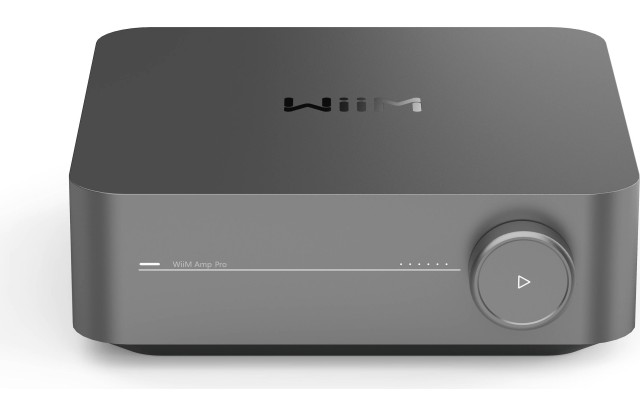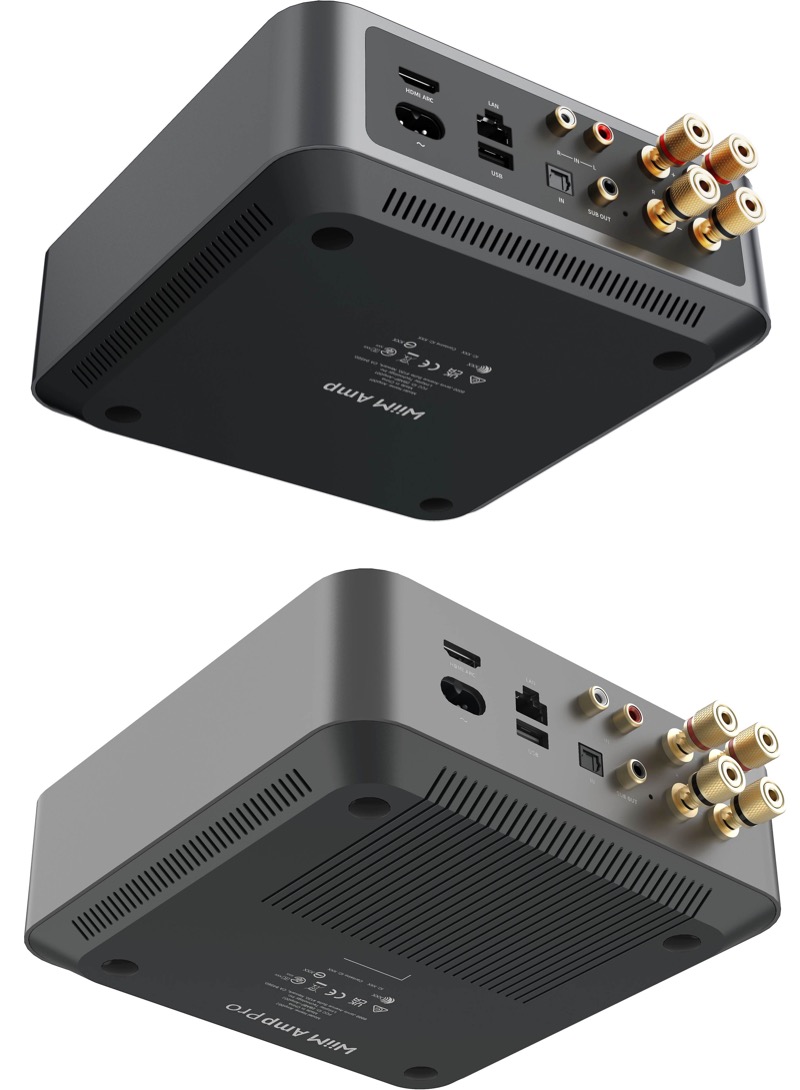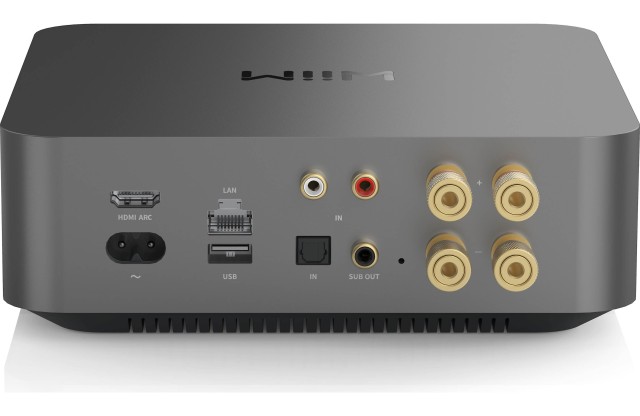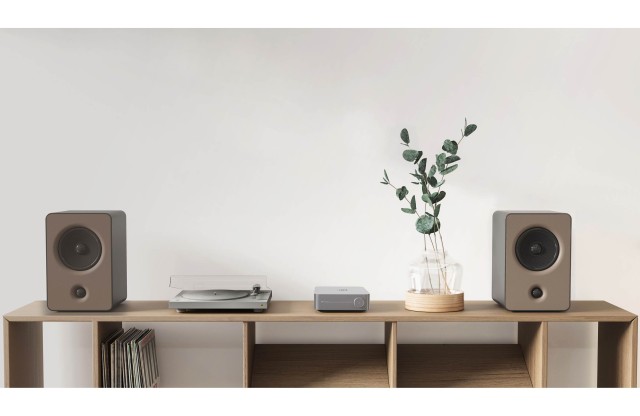Wiim Amp Pro vs. Wiim Amp: A Comparison of Two Compact Powerhouses
The original WiiM Amp made waves when it launched, offering an impressive array of features, streaming capabilities and refinement at an affordable price of just $299. Its blend of quality and functionality won over budget-conscious users and more advanced listeners alike. Many found it ideal for setting up a compact, minimalistic audio system for small rooms or offices, enjoying modern streaming services without needing to invest in powered speakers.
 Wiim Amp Pro
Wiim Amp Pro
WiiM Amp Pro Key Specs
- 60 watts RMS into 8-ohms
- Built-in ESS ES9038Q2M DAC
- Triple-back WiFi 6E (2.4, 5, 6 GHz)
- USB Input
- Bluetooth v5.3
- HDMI Input (ARC)
- Weight: 4.10 lbs / 1.85 kg
- Built-in Room Correction
- Dimensions (H x W x D):2.4375inch x 7.5inch x 8.625inch
Seeing the Amp’s success, Wiim released an improved version, the WiiM Amp Pro. By making a few meaningful upgrades to the original model, Wiim enhanced sound quality while keeping the cost manageable. The Amp Pro is priced at $379, just $80 more than the original, so let’s dive into the differences between these two models.
Externals
Externally, the Wiim Amp and Amp Pro are almost indistinguishable. Both have identical dimensions, according to manufacturer specifications. However, the Amp Pro has extra grilles on the bottom plate and redesigned feet, added to enhance thermal management. Wiim states that the Amp Pro incorporates a sophisticated thermal system with copper, aluminum, and graphene heat sinks to maintain reliable performance even under heavy use.
 Wiim Amp vs Amp Pro bottom plates
Wiim Amp vs Amp Pro bottom plates
Power Amp
Both units are powered by the same Texas Instruments TPA 3255 chip, delivering 60 watts per channel into 8 ohms (120 watts x 2 into 4 ohms). However, the Amp Pro includes Post-Filter Feedback (PFFB) technology, promising a cleaner, lower-noise output. The specifications support this: the Amp Pro boasts a signal-to-noise ratio of 120 dB and a THD+N of 0.0005% (-105 dB), compared to the original Amp’s 98 dB and THD+N of 0.0025% (-92 dB).
DAC
The DAC (digital-to-analog converter) is another notable improvement in the Amp Pro. While the original Amp uses an ESS SABRE HyperStream DAC, the Amp Pro features a more advanced ESS ES9038Q2M DAC. This upgrade should result in higher resolution and greater accuracy in audio playback.
 Wiim Amp Pro Connections
Wiim Amp Pro Connections
Wi-Fi
The Amp Pro is equipped with a triple-band Wi-Fi 6E chip, which offers faster speeds, greater range, and lower latency compared to the dual-band Wi-Fi 5 in the original Amp. This improvement is particularly valuable for users who plan to stream audio wirelessly.
Wi-Fi 6E vs WiFi 5 Features Comparison Table
| Feature |
Wi-Fi 6E |
Wi-Fi 5 |
| Frequency Bands |
2.4 GHz, 5 GHz, and 6 GHz |
2.4 GHz and 5 GHz |
| Maximum Speed |
Up to 9.6 Gbps |
Up to 3.5 Gbps |
| Latency |
Lower latency, optimized for fast connections |
Higher latency than Wi-Fi 6E |
| Range |
Extended range with improved stability |
Standard range |
| Device Density |
Supports higher device density, ideal for crowded environments |
Supports moderate device density |
| OFDMA (Orthogonal Frequency Division Multiple Access) |
Yes, improves efficiency in congested areas |
No |
| Target Wake Time (TWT) |
Yes, improves battery life for devices |
No |
Bluetooth
Bluetooth capability has also been enhanced in the Amp Pro, moving from Bluetooth 5.0 in the original Amp to Bluetooth 5.3. The newer version provides faster speeds, improved reliability, and a greater range. For those who prefer the simplicity of Bluetooth over Wi-Fi, this is a welcome addition.
Bluetooth v5.3 and v5.0 Features Comparison Table
| Feature |
Bluetooth v5.3 |
Bluetooth v5.0 |
| Data Transfer Speed |
Up to 2 Mbps (same as v5.0 but with better efficiency) |
Up to 2 Mbps |
| Range |
Up to ~240 meters in open space |
Up to ~240 meters in open space |
| Connection Reliability |
Improved reliability with enhanced interference management |
Standard reliability |
| Power Efficiency |
Higher efficiency, with optimized sleep states for devices |
Standard power efficiency |
| LE Audio Support |
Yes (allows high-quality audio over low energy) |
No |
| Latency |
Lower latency, especially beneficial for gaming and calls |
Higher latency compared to v5.3 |
| Enhanced Attribute Protocol (EATT) |
Yes, for improved data throughput and reduced latency |
No |
| Audio Codec Support |
Supports LC3 codec for better audio quality |
Supports SBC and AAC (limited) |
| Security |
Enhanced security features for authentication and encryption |
Standard security |
Apple AirPlay Support
A surprising omission in the Amp Pro is the lack of Apple AirPlay and AirPlay 2 support, which was present in the original model. This exclusion is unlikely due to technical limitations and may be a strategic decision by Wiim. For users who rely on AirPlay, the original Wiim Amp remains the better choice.
 Wiim Amp Pro Lifestyle
Wiim Amp Pro Lifestyle
Price
The Wiim Amp Pro is priced at $379, while the original Amp is $299. Given the Amp Pro’s enhancements, we feel that the $80 price difference is justified for those starting fresh—unless AirPlay is essential, in which case, the original Amp may be preferable.
Final Thoughts
We hope you found this comparison of the Wiim Amp and Wiim Amp Pro insightful. We’ve highlighted the main differences between the two, but if you know of other distinctions or have real-life experience with these models, please share your thoughts!
For more information, visit the product pages for the WiiM Amp Pro and the WiiM Amp or explore our detailed comparison of the two.